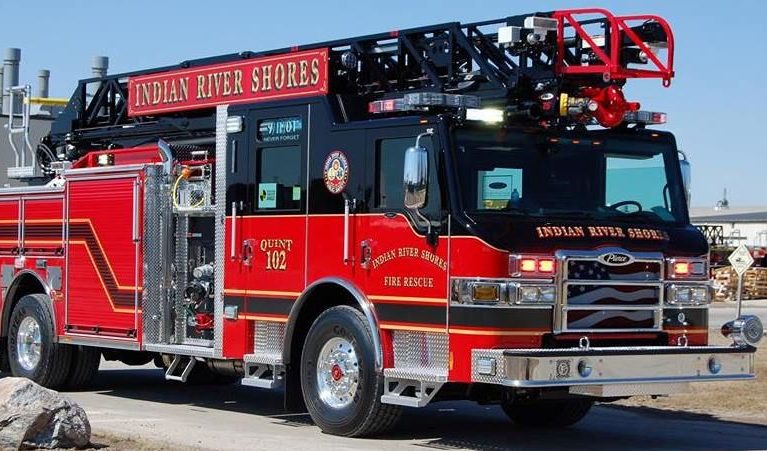
INDIAN RIVER SHORES — Most parents wouldn’t feel safe sending their son or daughter off to college, or even across town, in a 1989 model car, but that’s the age of the Indian River Shores Public Safety Department’s ladder truck used to hoist firefighters up to rescue trapped condo residents or to fight a fire from above.
The department’s pumper truck is just slightly newer, circa mid-1990s.
Granted, industrial vehicles have a longer lifespan than a passenger car, but the 50-foot ladder truck has been out of industry safety compliance for nearly five years even though the town has had the money to replace it – about $700,000 annually in cash that streams in from the state from the optional penny sales tax.
The money can only be spent on vehicles, or on bricks-and-mortar capital improvements. It can’t be used for salaries or general operating expenses, or to offset property taxes levied on homeowners.
If unused, the money just sits in the bank for a rainy day.
But every year, council members voted to put off the purchases, speculating they could get “one more year” out of the emergency equipment.
The council has in recent years replaced both of its older-model ambulances.
This year, former public safety chief and career firefighter Robert Stabe used his new position as town manager to push the issue of the fire trucks.
He got the vote to purchase not only the two new fire trucks, but also four new administrative vehicles for public safety supervisors and a new patrol car.
Those expenses will boost the town’s annual budget about 27 percent from $4.3 million to $5.5 million, but it won’t impact property taxes. In fact, Stabe said it will help the town save money on maintenance and manage its risk better.
“Corrosion is also an issue with the extreme salt environment here on the ocean,” Stabe said.
Affecting both the exterior and the mechanical parts, corrosion can trim five to 10 years off the typical 20-year life of the vehicle.
Though the town has maintenance and repair agreements on the vehicles with Bradenton-based Ten-8 Fire Equipment Inc., the day-to-day work of cleaning, polishing, testing and inspecting all the working components of the public safety vehicles rests on the staff.
Having an aging fleet that includes a vehicle that’s out of safety compliance opens the town up for potential litigation should something go wrong, Stabe said.
He noted that the new truck will have an enclosed area where firefighters ride to and from the scene of a call, where the old truck had open seating except for the driver and passenger in the cab.
In addition to everything being new and under warranty with state-of-the-art equipment and technology, the new ladder truck will have a higher reach of 75 feet and the ability to pump water up the entire ladder length. This feature would free the new pumper truck, which can spray 1,250 gallons per minute, to be at the scene of another structure fire should multiple incidents occur simultaneously or a fire spread to a neighboring home.
Three of the four administrative vehicles are Chevy Tahoe sport utility vehicles and two of those are four-wheel drive so the department has a way to get around amid standing water and debris.
“Because the town is a barrier island community, we need to have a minimum of two larger SUV’s to be used in the event of a hurricane,” Stabe said.
“Both the two fire apparatus, the four admin vehicles, and one patrol vehicle are all being purchased with Discretionary Sales Tax (Infrastructure) funds, not through the general fund,” he said.
Why so many vehicles all in one year?
“The same situation happened with the admin vehicles as the old ladder truck,” Stabe said. “The Council continued to put off replacing them and that is why we had to replace all of them at once. We developed a five-year capital budget within next year’s budget allowing us to stagger replacing the vehicles in the future. Average lifetime of admin vehicles is five to seven years.”
The decision to spend nearly $1.3 million on the vehicles did not come without some hand-wringing on the dais. There was talk of leasing the vehicles and even of purchasing them on credit, but Stabe got support for the outright purchases from John’s Island resident Councilman Dick Haverland, according to budget workshop minutes.
“Councilman Haverland said we should spend the money and deplete the emergency fund; we have cash. The economics is that if you lease it for 10 years and assume 2 percent inflation, it costs $1.9 million, whereas to buy it is $900,000. He said he talked to three fire chiefs in three counties about the life of the truck, and they said there is no question that the trucks have a 20-year life, although the maintenance in years 11-20 is higher than during years 1-10,” the minutes state.
After discussion over the opportunity cost of using the cash and not having it in the bank to repair buildings or replace vehicles in the event of hurricane damage, Mayor Brian Barefoot announced a consensus to buy the vehicles.



